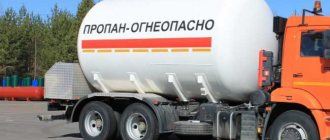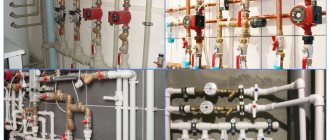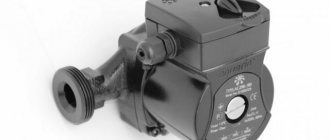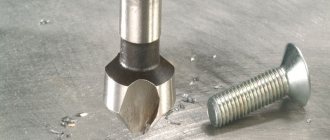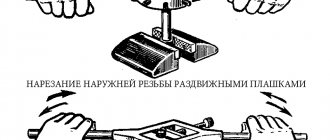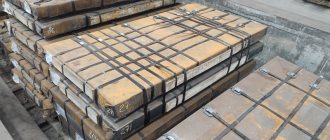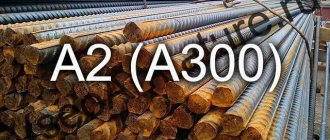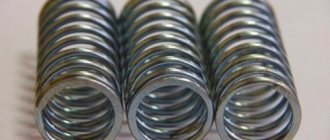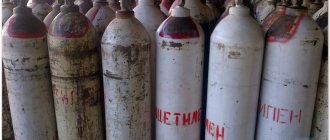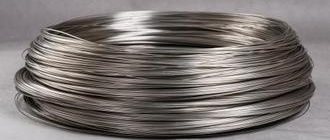December 17, 2015
Gas burners are an indispensable assistant in the household, workshops and production shops, on a picnic and on hikes. Ease and ease of use have long given the primacy to gas appliances over other types. When choosing a burner, you should take into account the scope of application, the required power, as well as the maximum flame temperature. The last factor is especially important when performing more delicate types of work. Therefore, it is necessary to know the basic parameters directly related to the temperature distribution of the gas burner flame.
What determines the temperature of a gas burner flame?
A gas burner in a can and the flame temperature in it directly depends on the composition of the gas fuel, the ambient combustion conditions and the power of the equipment used. In this case, a direct relationship is observed between the calorific value of the gas and the temperature of the flame torch - an increase in the first indicator leads to an increase in the second.
When the process of mixing the fuel used with air occurs, the gas is completely consumed, which in turn increases the burning rate and increases the flame temperature. This indicator can be improved through additional use of air blast. For example, without the use of blowing, the maximum temperature regime is 1500 °C, but when using it, results up to 2200 °C are possible.
The temperature is also affected by the flame pattern. It is not homogeneous and is divided into three zones:
- internal - is the shortest and has the lowest temperature indicators. It is in it that the gas mixture is heated, but without combustion;
- The average reduction zone is the so-called light fire zone, in which the highest temperature is reached. Combustion already occurs here, but not at full power, due to the lack of oxygen and the presence of carbonaceous gas decomposition products;
- bordering - characterized by the lightest flame, is oxidizing. The temperature of this zone is also high and due to excess air, complete combustion of the gas occurs.
All about the temperature of gas burners
- What does it depend on?
- What temperatures do different types produce?
- How to adjust?
Despite the great popularity of electric stoves and other similar electric heating devices, the use of simple gas burners still remains relevant both in everyday life and in production.
When using burners, few people seriously think about the flame temperature. However, it is precisely this factor that determines the scope of application of the burner. Read below for all about what the temperature of a gas burner depends on and how to regulate it, as well as many other interesting facts.
Use of technical propane
Technical propane can be used in the following areas:
- as fuel for trucks, when performing various types of work in industry;
- in construction: for cutting scrap metal, welding, during roofing work, for heating asphalt, for heating premises;
- in everyday life for cooking, heating the house, heating water;
- in the food and chemical industry for solvents or as a food additive known as E944.
Burner parameters
Gas burners for a cartridge with a collet connection represent a separate class of tools. They are used in conditions of high fire safety where serious construction equipment is involved, and the risk of damage to the apparatus is minimized.
The main parameters are temperature and flame shape. In the simplest devices, the combustion temperature is close to the minimum - 700−1000°C. Air comes naturally and there is never enough of it. More expensive products have a special shape of air supply channels, which increases air flow and the flame temperature increases to 1200°C.
The flame has an even higher temperature in ejector burners, in which air is supplied to the hearth due to rarefaction, and the flow force is directly proportional to the operating gas pressure. Thanks to this, the temperature can be increased to 1500−1600°C and relatively smoothly adjusted with the flame length just by turning the tap. There may be several sources of combustion in the apparatus. This tool does not perform delicate work, but it successfully heats large areas.
The threshold temperature of the burners is 2000−2400°C, and it is achieved by concentrating the injected air into the combustion chamber, as well as using methyl acetylene propadiene gas (MAPP). A high-temperature cone is formed in the flame, whose power and temperature can be compared with oxy-fuel welding.
In addition, any type of product can be equipped with a flexible or rotary tube, piezo ignition and a highly sensitive control valve. There is a wide selection of devices based on power and gas consumption .
Adjustment
The cleanliness of the cut depends on the correct flame setting . Oxygen treatment is carried out with a slightly oxidized or normal torch. The carefully adjusted flame of cutters with concentric nozzles is surrounded by a cutting stream of oxygen. The core of the torch in each section should be symmetrical and not differ in brightness.
Cutting with a torch with the mouthpiece moved cannot be carried out, as this will lead to heating of the edge, which will negatively affect the quality of the cut. The use of self-centering mouthpieces increases the ease of use of such equipment, because the device makes the flame symmetrical.
Sometimes the movement of the gas mixture is hampered due to clogging of the channel, which divides the torch into streams and leads to loss of stability. Such a product not only reduces the quality of processing, but also reduces productivity. Flame adjustment is based on creating a symmetrical flame of the required power in relation to the oxygen cutting jet.
Important! The installed combustion power is determined by the thickness of the material.
A normal flame is ensured with the valves slightly open, which makes it possible to make adjustments during operation. When acetylene and oxygen are fully open, an excessive amount of the former is observed. Smooth closing of the acetylene valve leads to stabilization of the process.
Rexant GT-19
- Fuel type – propane-butane mixture.
- The connection is collet.
- Flame temperature – 1400 ºС.
- Gas consumption – 80 g/hour.
- Overall dimensions – 153x40x57 mm.
- Weight – 135 g.
Rexant GT-19 is a compact and convenient burner designed for connection to standard gas cylinders using a collet connection. The model can be used for a variety of jobs involving flame processing, including removing old paint, lighting fires, barbecues and stoves, soldering pipe connections, and insulating wires using heat-shrinkable materials. Thanks to the built-in piezoelectric element, ignition is carried out with one touch.
After two minutes of warming up, the burner can be held at any angle, based on the characteristics of the work being performed. The design provides the ability to adjust the flame, which ensures economical fuel consumption. Recommended continuous operation time is no more than 30 minutes. It should be remembered that the burner is a subject of increased fire hazard. It is prohibited to be transported on public transport or left unattended while working. During operation, the device requires minimal human intervention. Maintenance comes down to periodically cleaning the burner from contaminants that could lead to clogging of the nozzle.
Gas combustion air
If you take air from the common ventilation duct, this will have a bad effect on the operation of the system. This is due to the fact that the ventilation duct has common walls with the bathroom, kitchen or toilet. If the temperature outside is negative, then after a while the temperature in the ventilation duct will be 1 degree, and in the room adjacent to the duct there will be an uncomfortable atmosphere. Agree, it is unpleasant to be in a cold bathroom or cook in a cool kitchen. Therefore, it is not advisable to take air from the general ventilation duct.
Temperature conditions of different types of burners per cylinder
You can purchase a burner online or at a hardware store. It is better to give preference to the second option, since the buyer can consult with an experienced seller, he will select the appropriate option depending on the tasks set by the user. The product range includes models that differ in temperature conditions:
- Refillable. They are characterized by small dimensions and thoughtful shape, as well as ease of use and a piezoelectric element. This type does not apply to the cylinder variety of gas burners.
- On a collet can. They are a source of powerful flame with an average outlet temperature of 1500 degrees.
- Threaded. Propane accounts for the lion's share of the fuel, due to which the temperature in the combustion zone is 1800 degrees. Advanced models are equipped with systems for mixing air with a propane mixture.
What does it depend on?
The burner temperature is determined by the chemical composition of the gas and the power of the product. During the research, it was possible to establish that the temperature parameters of the torch depend on the calorific properties of the gas mixture.
After combining the fuel with air, the gas is consumed critically, so the combustion intensity increases. By using an additional air source, you can increase the temperature you get at the burner. Without blowing, the value reaches 1500 degrees; access to auxiliary air flow gives an increase of up to 2200 degrees. The temperature differs in different parts of the torch :
- Internal . This is a short zone with little heating.
- Average . In this area, the temperature of the flame from the gas burner reaches its limit, but the fire does not open completely, which is due to a lack of oxygen and the release of decay products.
- Bordering . Visually characterized by a bright fire with high efficiency.
Cheap burner models are structurally the same. Expensive ones are equipped with additional elements that increase technical characteristics and ease of use.
To perform welding and cutting, special requirements are placed on the composition of the gas mixture, since the temperature regime of the product depends on it.
Schematic representation of a gas burner flame
The first step is to figure out what parts the burner flame consists of. This can be done using the simple diagram below.
In this schematic diagram, the following flame areas are indicated by letters:
- O – area of oxidizing flame; here the air-gas mixture burns completely, and an increased oxygen content is observed.
- B – recovery area. Here the gas does not burn completely, since it does not have enough oxygen for this. As a result, it breaks down into molecules that are combustion products. It is they who burn out completely in the oxidizing flame.
- A is the area in which the formation of the air-gas mixture occurs. Here the combustion process does not occur at all.
The numbers on the diagram are intended to indicate areas with different flame temperatures. The latter increases in regions, starting from region A and ending with the reducing part of the flame. In the process of complete combustion of gas, it decreases slightly:
- Areas 1-4. At the very bottom the temperature is 300 degrees and rises first to 320 and then to 520 degrees. In the area indicated by the number 4, it reaches a value of 1540 degrees.
- Areas 5-8. Here the temperature is 1550-1560 degrees in the center and 450 degrees at the edges. The maximum value of 1570 degrees can be observed at the very tip of the reducing part of the flame.
- 9 is an oxidizing flame, the temperature of which reaches 1540 degrees.
Classification
Flames are classified according to:
- state of aggregation of flammable substances: flame of gaseous, liquid, solid and aerodispersed reagents;
- radiation: luminous, colored, colorless;
- state of the fuel-oxidizer environment: diffusion, pre-mixed media;
- the nature of the movement of the reaction medium: laminar, turbulent, pulsating;
- temperature: cold, low temperature, high temperature;
- propagation speeds: slow, fast;
- height: short, long;
- visual perception: smoky, transparent, colored.
In a laminar diffusion flame, 3 zones (shells) can be distinguished.
Inside the flame cone there are:
- dark zone (300-350 °C), where combustion does not occur due to a lack of oxidizing agent;
- luminous zone where thermal decomposition of fuel and its partial combustion occurs (500-800 ° C);
- a barely luminous zone, which is characterized by the final combustion of fuel decomposition products and a maximum temperature (900-1500 ° C).
Connection standards
There are quite a few different replacement cartridges on the market. It is customary to distinguish the following connection types:
Such cartridges comply with European standards. The thread of such products is 7/16. Most often you can find products with a volume of 110, 230 and 450 grams. There are several types of threaded cylinders of this standard, the first produce a temperature of about 1300 degrees, and the second, which uses copper soldering, produces a temperature from 1500 to 2500 degrees. The level of combustion temperature directly depends on the characteristics of the gas mixture. The burner is attached to such a product using screw-on methods.
These cartridges comply with American MAPP standards. Mostly they are filled with a special mixture intended for soldering copper. Its combustion temperature varies from 1500 to 2500 thousand degrees. The burner is also attached by screwing.
Products of this standard are among the most widespread and inexpensive. The cylinder is fixed using a special fastener. Additionally, the product is equipped with a safety valve.
This type of product is used primarily for refilling various products.
The best Gorenje combination boards
Gorenje KC 5355 XV
A modern model with a multifunctional electric oven. The working surface is made of high-strength glass ceramics. The grates are cast iron and can be easily removed for cleaning. The oven is equipped with 11 working programs and uses the IconLED sensor for control. In addition to AquaClean steam cleaning, there is a catalytic panel that breaks down grease into carbon dioxide and water. Product dimensions 500x600x850 mm.
Peculiarities:
- vaulted oven with a capacity of 70 liters. Dishes are heated evenly, just like in a wood-burning oven;
- GentleClose technology with smooth door closing;
- BigSpace is a large oven with a vaulted ceiling. Now roasting a whole turkey will no longer be a problem;
- cooking on several levels. Free air circulation ensures heating of dishes, maintaining the required temperature, and helps save time and electricity;
- thoughtful placement of heaters in the oven, allowing you to cook meat and baked goods with an appetizing crust;
- FastPreheat - fast heating. A temperature of 200 degrees is reached within 6 minutes. The time savings is about 30%. A sound signal and light indication indicate that the set temperature has been reached;
- electric grill. The kit includes a spit;
- high energy efficiency (energy class A).
Gorenje K 5341 WF
Combination device with innovative gas burners and electric oven. The design features of the burners allow you to optimize gas consumption and the efficiency of its use. Control is traditional, using mechanical switches. The type of coating on the hob is enamel. The capacity of the oven is 70 liters, it has a vaulted shape characteristic of Gorenje products. Thanks to the triple inner coating, almost perfect thermal insulation is ensured.
Advantages:
- Beautiful design;
- BigSpace - a huge oven space that provides maximum freedom for culinary experiments;
- cooking on several levels;
- elegant gratings made of high-strength cast iron;
- automated electric ignition;
- energy consumption class - A;
- spacious dish drawer.
No deficiencies have been identified.
Gorenje K 52 CLB
A stylish and reliable stove that successfully combines classic design with modern materials and technologies. The 4-burner hob is enameled and has a removable cast iron grate. The front panel is equipped, in addition to rotary controls, with a built-in clock with a timer and backlight. The capacity of the electric oven is 70 liters. Product dimensions 500x600x850 mm.
Advantages:
- sound timer;
- electric oven with solid equipment: convection, electric grill, double glass, cooling fan and backlight;
- automated electric ignition;
- gratings made of high-strength cast iron;
- convenient compartment for kitchen utensils;
- gas control function;
- modern, very stylish design.
Disadvantages: none.
Gorenje K 52 CLI
A combined slab measuring 500x600x850 mm, designed in a classic style, with bronze fittings. The hob is gas, equipped with automatic electric ignition. The capacity of the vaulted electric oven is 70 liters. Double glass minimizes its heating. Energy class - A.
Advantages:
- spacious electric oven with convection, cooling fan, lighting and double glass;
- good energy efficiency;
- gas control.
Cons: none.
Gorenje K 5241 WH
Combination oven with gas hob and electric oven. Air circulation in the interior of the oven helps food heat up evenly. The control panel is mechanical, equipped, in addition to rotary switches, with a timer with a shutdown function. There is an automated electric ignition. The dimensions of the slab are 500x600x850 mm, like most versions from Gorenje. The hob has a practical enamel coating. The grates are made of durable cast iron.
Oven features:
- double glass;
- capacity 70 l;
- backlight;
- electric grill
Advantages:
- functionality, uniform heating of dishes;
- ease of operation;
- wonderfully stylish design (just look at the photo);
- low price;
- convenient and spacious dish compartment;
- official warranty from the manufacturer - 1 year.
There are no negative reviews.
Design features and operating principle
Burners vary in design - from basic devices with a nozzle to more complex mechanisms equipped with an air supply device and piezo ignition.
Let's consider the design of a torch designed for welding metal.
The design with an injector and check valve increases work productivity and reduces fuel consumption.
Almost all portable household appliances belong to the so-called injection burners, when air is naturally sucked into the burner to support the flame.
Inside, in a special chamber, fuel is mixed with air, as a result of which the fuel ignites after a spark is given.
From the mixing chamber, the mixture of gases enters the nozzle-nozzle, where it is distributed through the channels. At the end of the structure, at the point where the torch is formed, there are fire holes - the ends of the channels.
Spread speed
Flame propagation through a pre-mixed (undisturbed) medium occurs from each point of the flame front normal to the flame surface. The magnitude of this normal flame propagation speed (hereinafter referred to as NFSP) is the main characteristic of a flammable environment. It represents the minimum possible flame speed. NSRP values differ for different combustible mixtures - from 0.03 to 15 m/s.
The spread of flame through real-life gas-air mixtures is always complicated by external disturbances caused by gravity, convective flows, friction, etc. Therefore, the actual flame propagation speeds always differ from normal ones. Depending on the nature of combustion, flame propagation speeds have the following ranges of values:
- deflagration combustion – up to 100 m/s;
- explosive combustion – from 300 to 1000 m/s;
- detonation combustion – over 1000 m/s.
The color of the flame is determined by the radiation of electronic transitions (for example, thermal radiation) of various excited (both charged and uncharged) particles formed as a result of a chemical reaction between fuel molecules and oxygen in the air, as well as as a result of thermal dissociation. In particular, when carbon fuel burns in air, the blue part of the flame color is due to the radiation of CN ±n particles, the red-orange part is due to the radiation of C2 ±n particles and soot microparticles. The radiation of other particles formed during the combustion process (CHx ±n, H2O ±n, HO ±n, CO2 ±n, CO ±n) and main gases (N2, O2, Ar) lies in the UV and IR part of the spectrum, invisible to the human eye. In addition, the color of the flame is greatly influenced by the presence of compounds of various metals, primarily sodium, in the fuel itself, the design details of burners, nozzles, and so on. In the visible part of the spectrum, the radiation of sodium is extremely intense and is responsible for the orange-yellow color of the flame, while the radiation of the slightly less abundant potassium turns out to be practically indistinguishable against its background (since most organisms have K+/Na+ channels in their cells, then in the carbon fuel of plant or animal origin for every 3 sodium atoms there are on average 2 potassium atoms).
Source: Tideman B.E., Sciborsky D.B. Chemistry of combustion. –L., 1935.
Rating of gas burners for soldering and repair
1st place – mini gas burner with soldering attachment
Designed for both heating medium-sized parts and for contact soldering due to the heating of the tip from the flame. A kind of soldering iron without wires. The gas tank capacity is 8ml. The flame temperature when filling with butane reaches 1300 degrees Celsius, and the tip temperature – 450 degrees. The flame length is adjustable from 4 to 6 cm. The burner length is 13 cm and the diameter is 1.5 cm.
small and inexpensive, the refill is enough to solder several medium-sized parts, there is a nozzle for contact soldering, it is easy to refill.
2nd place – gas micro burner
There is nothing in it except a tank with a filling valve and a nozzle with a gas supply regulator. The ZC57100 does not have piezo ignition and it is supplied unfilled, so you will also have to buy a gas cartridge - it will be suitable for lighters. In general, to solder two wires or heat heat shrink without a soldering iron, such a torch is enough. The burner is also about 20 cm long and weighs 43 g.
This is the cheapest burner that can be found and the price of such a micro burner is 200 rubles.
the cheapest, easy to refill.
small flame, the filling runs out quickly, there is no piezo ignition.
3rd place – mini gas soldering iron KVT XZ-1
This remarkable soldering iron from the gas powered brand features piezo ignition and comes in a case with a set of 4 soldering tips, a spool of solder, and a tip cleaning sponge. Thus, the declared power of the soldering iron for contact soldering is 137 W - this is a lot for a soldering iron with a length of 21 cm and a weight of 120 g. Electric soldering irons have never dreamed of such weight and size characteristics. This soldering iron is not positioned as a torch, but it can be used as a torch - the flame is pencil-type.
This soldering iron is good for everyone, except for the price of 2300 rubles, which is why it landed in 3rd place.
burner from a famous brand, easy to solder, set of components, good case, high heat output.
4th place – gas burner IRIS BARCELONA
This torch is not only designed for soldering, welding, repairing electronic devices and jewelry. The flame of this burner is of course adjustable. Can be charged with a standard lighter gas cylinder. The flame length reaches 3 cm. The operating time is about 20 minutes. The flame temperature reaches 1300 degrees Celsius. The length of the burner itself is exactly 20 cm.
small size, piezo ignition, brand.
The length of the flame does not allow heating medium and large parts.
5th place – butane burner KVT X-220
It is positioned as a burner for construction and repair work. She looks very stylish. The knurled handle fits nicely in the hand. Has a piezoelectric flame ignition system. The capacity of the cylinder for highly purified butane is 22 ml. This amount of gas is enough for 110 minutes of continuous operation. The flame length is adjustable from 30 to 80 mm from a sharp wedge-shaped flame to a soft flame with yellow tongues. The weight was only 226 grams with a length of 14 cm.
a good option for desktop work, there is a stand, piezo ignition, and a comfortable handle.
It's bulky, you can't put it in your pocket, you can't fit it into a narrow place.
Gas stations
CNG filling station
gas station
Gas filling stations are found with the abbreviations AGNKS and AGZS. They indicate the type of gas that is used to fill the car.
CNG filling stations stand for automobile gas filling compressor station. Designed for methane and located outside the city.
AGZS stands for automobile gas filling station. Designed for propane.
The number of gas filling stations is many times greater than that of CNG filling stations. It turns out to be a vicious circle. Methane is more difficult to store; the cylinders are thick and heavy. You also need to try to find a gas station. And this additionally affects the popularity of this gas.
How to adjust?
Adjusting the burner flame is to set the flame to normal. A normal flame is a symmetrical flame core and the flame itself of the required power. In this case, the color of the flame should also be uniform and symmetrical, it should not differ in brightness. To do this, first light the burner, open the oxygen valve and reduce the flow of acetylene. After some time, it will be possible to see changes in the shape of the flame. Once the flame reaches the desired size, the oxygen valve must be closed. This method is not suitable for gas cans with a soldering iron. In them, the fuel supply is uniform and does not require adjustment. Typically, the flame of such products can be controlled by a valve located on the outside of the device.
When purchasing a gas burner, you need to pay attention to the presence of a rotating tube and valve design. The valve must be sensitive. And the rotating tube will make it easier to use the device - it will be possible to direct the flame in the desired direction. If the burner mouthpiece is moved, you cannot use such a device - this can lead to poor-quality processing of the products (especially if you are making cuts).
The accuracy of flame power control can also be affected by a clogged device channel.
In the next video you will find a brief overview of the gas burner.
Basic physical and chemical properties of LPG components and their combustion products
You are here: Home » Basic physical and chemical properties of LPG components and their combustion products
Physico-chemical parameters of LPG
The main characteristics of LPG include:
- evaporation/condensation temperature;
- ignition temperature;
- heat of combustion;
- density;
- volume expansion.
Important characteristics are the explosive limits when mixed with air, the speed of fire spread during combustion, and the conditions for complete combustion.
Evaporation/condensation temperature
At normal pressure is:
- for propane – minus 42 °C;
- for butane – minus 0.5 °C.
If the temperature of gases rises above these values, they begin to evaporate; when they fall below, they begin to condense. As a rule, liquefied gas is supplied in the form of a mixture (butane + propane). Therefore, the actual evaporation/condensation temperature depends on their ratio.
Typically, gas supplied in winter retains its volatility down to minus 20 °C. But sometimes the manufacturer supplies the mixture with an increased amount of butane. This leads to the fact that even with a slight drop in temperature below zero, the gas stops evaporating.
Flash point
- for propane – from 504 to 588 °C;
- for butane – from 430 to 569 °C.
At these temperatures, the gas can ignite even in the absence of an open flame - if there are objects that are heated to a high temperature, but are not yet glowing.
Heat of combustion
This parameter characterizes the amount of heat released during the combustion of 1 m3 of gas. It is equal to:
- for propane – 22…24 thousand kcal. (91...99 MJ/m3);
- for butane - 28...31 thousand kcal. (118...128 MJ/m3).
Explosion limits
This is a very important feature from a safety point of view. At a certain ratio, a mixture of gases with air or oxygen can explode. The likelihood of an explosion depends on the speed at which the fire spreads. The higher it is, the more dangerous the situation. In turn, the rate of fire spread depends on the proportion of gases. It must be borne in mind that as the temperature increases, the explosive limits expand.
When a gas is mixed with air, it becomes explosive at the following ratios:
- propane – 2.1%...9.5%;
- butane – 1.5%...8.5%;
- mixture – 1.5%...9.5%.
Density
The normal density of the gaseous phase is:
- propane – 2.019 kg/m3;
- butane – 2.703 kg/m3.
The density of the liquid phase is 0.5...0.6 kg/l.
